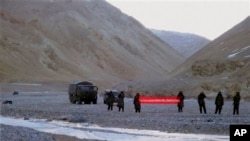NEW DELHI, INDIA —
India and China have resolved a three-week standoff over an ice-covered plateau along their disputed Himalayan border.
The confrontation, the latest strain on the sometimes uneasy ties between the Asian giants, had threatened to cast a shadow over the upcoming visit by India’s foreign minister to Beijing.
The tense, 20-day crisis in the northern Ladakh region began when about 50 Chinese soldiers pitched tents deep inside what New Delhi claims is its territory, and ended with both sides returning to their original positions.
The de-escalation occurred along what is called the Line of Actual Control, a vaguely defined line in the mountain plateau which both sides dispute.
“The governments of India and China have agreed to restore the status quo ante along the Line of Actual Control as it existed prior to 15th April, 2013," said Syed Akbaruddin, spokesperson for the Indian Foreign Ministry. "Flag meetings have been held to work out the modalities and work out the arrangements.”
Indian army officials said there was a simultaneous pullback Sunday evening following a meeting between commanders from both countries. Chinese troops pulled down their tents while Indian soldiers, who had moved within 300 meters of the Chinese soldiers, also returned to the positions held before the dispute.
Such disputes have erupted between the Asian giants in the past, along their unmarked border, but India considers the latest incursion the worst in years. The area, which is close to an airstrip used by Indian troops, is considered strategic.
The massive public outcry might have compelled the Indian government to take a tough stand with Beijing.
“It was a move by the Chinese to test Indian resolve," said Bharat Karnad, a strategic affairs analyst at New Delhi’s independent Center for Policy Research. "The public reaction to it was so fulsome that I think it may have persuaded Beijing to put on a more conciliatory face, and that’s what has happened.”
A Chinese Foreign Ministry spokeswoman said both sides had adopted a constructive attitude in the larger interests of bilateral relations.
Hua Chunying said maintaining peace and tranquility serves the common interests of the two sides, and that China is ready to join hands with India to seek a mutually acceptable and fair solution to the border issue at an early date.
The resolution of the dispute has paved the way for Indian Foreign Minister Salman Khurshid to visit Beijing on Thursday. A formal announcement of his trip was made by the Indian foreign ministry Monday, quieting speculation in the local media that the minister considered calling off his visit if the standoff was not resolved.
Khurshid is expected to set the groundwork for a trip to India later this month by Chinese Premier Li Keqiang, in what is expected to be his first official overseas trip since coming to power.
The border dispute dates back to a war the two countries fought in 1962; China claims rights to India’s eastern state of Arunachal Pradesh, while India claims chunks of the Himalayan plateau in Ladakh held by China.
The confrontation, the latest strain on the sometimes uneasy ties between the Asian giants, had threatened to cast a shadow over the upcoming visit by India’s foreign minister to Beijing.
The tense, 20-day crisis in the northern Ladakh region began when about 50 Chinese soldiers pitched tents deep inside what New Delhi claims is its territory, and ended with both sides returning to their original positions.
The de-escalation occurred along what is called the Line of Actual Control, a vaguely defined line in the mountain plateau which both sides dispute.
“The governments of India and China have agreed to restore the status quo ante along the Line of Actual Control as it existed prior to 15th April, 2013," said Syed Akbaruddin, spokesperson for the Indian Foreign Ministry. "Flag meetings have been held to work out the modalities and work out the arrangements.”
Indian army officials said there was a simultaneous pullback Sunday evening following a meeting between commanders from both countries. Chinese troops pulled down their tents while Indian soldiers, who had moved within 300 meters of the Chinese soldiers, also returned to the positions held before the dispute.
Such disputes have erupted between the Asian giants in the past, along their unmarked border, but India considers the latest incursion the worst in years. The area, which is close to an airstrip used by Indian troops, is considered strategic.
The massive public outcry might have compelled the Indian government to take a tough stand with Beijing.
“It was a move by the Chinese to test Indian resolve," said Bharat Karnad, a strategic affairs analyst at New Delhi’s independent Center for Policy Research. "The public reaction to it was so fulsome that I think it may have persuaded Beijing to put on a more conciliatory face, and that’s what has happened.”
A Chinese Foreign Ministry spokeswoman said both sides had adopted a constructive attitude in the larger interests of bilateral relations.
Hua Chunying said maintaining peace and tranquility serves the common interests of the two sides, and that China is ready to join hands with India to seek a mutually acceptable and fair solution to the border issue at an early date.
The resolution of the dispute has paved the way for Indian Foreign Minister Salman Khurshid to visit Beijing on Thursday. A formal announcement of his trip was made by the Indian foreign ministry Monday, quieting speculation in the local media that the minister considered calling off his visit if the standoff was not resolved.
Khurshid is expected to set the groundwork for a trip to India later this month by Chinese Premier Li Keqiang, in what is expected to be his first official overseas trip since coming to power.
The border dispute dates back to a war the two countries fought in 1962; China claims rights to India’s eastern state of Arunachal Pradesh, while India claims chunks of the Himalayan plateau in Ladakh held by China.












